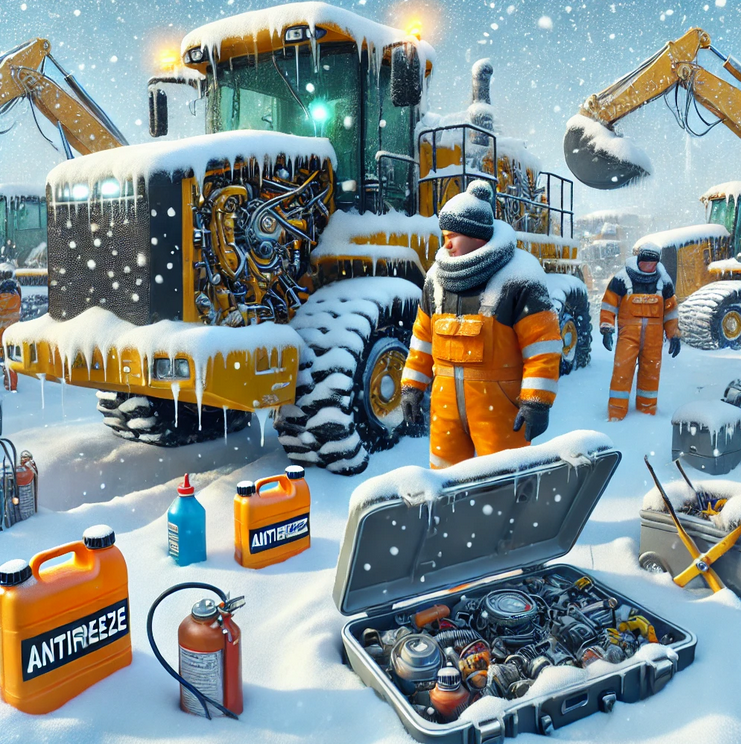Maintaining Equipment in Freezing Conditions: Winterization Best Practices
Operating equipment in freezing temperatures presents unique challenges that can lead to breakdowns, inefficiencies, and safety hazards. Maintaining equipment in freezing conditions with proper winterization best practices ensures smooth operations, longevity, and safety.

This guide outlines essential strategies for winterizing equipment to keep it functioning effectively during cold weather.
Why Maintaining Equipment in Freezing Conditions is Crucial
Winter conditions can cause severe wear and tear on equipment, impacting its performance and increasing maintenance costs.
Freezing temperatures can lead to brittle materials, frozen fluids, and malfunctioning parts, making winterization vital for construction, transportation, and industrial operations.
Key Risks of Ignoring Winterization:
- Fluid Freezing: Engine oils and hydraulic fluids can thicken, reducing efficiency.
- Brittle Materials: Extreme cold can make hoses, wires, and seals crack or snap.
- Delayed Operations: Equipment failure in winter can disrupt timelines and lead to costly downtime.
Preparing Equipment for Freezing Conditions
1. Inspect and Service Equipment Before Winter
A thorough inspection before winter ensures all components are ready to withstand freezing conditions.
- Check for Damage: Look for cracks, leaks, or wear in hoses, seals, and wires.
- Replace Fluids: Use antifreeze-rated engine oils and hydraulic fluids.
- Test Batteries: Ensure batteries are fully charged and connections are secure.
| Component | Inspection Focus |
|---|---|
| Hoses & Seals | Cracks and leaks |
| Fluids | Antifreeze compatibility |
| Batteries | Charge level and connections |
Tip: Schedule equipment servicing in late autumn to address issues before freezing temperatures set in.
2. Use Cold-Weather-Compatible Fluids
Fluids play a crucial role in maintaining equipment efficiency, even in subzero temperatures.
- Engine Oils: Switch to low-viscosity oils that flow easily in cold weather.
- Hydraulic Fluids: Use winter-grade hydraulic fluids to maintain system responsiveness.
- Fuel Additives: Add anti-gel agents to diesel fuel to prevent crystallization.
Learn more about winter-grade fluids at Construction Equipment Guide.
3. Protect Electrical Components
Cold weather can impact the performance of electrical systems, making proactive measures essential.
- Insulate Wires: Prevent brittleness and damage by using protective wraps.
- Check Connections: Ensure all electrical connections are tight and corrosion-free.
- Store Batteries Indoors: Keep spare batteries warm when not in use.
Operating Equipment Safely in Freezing Conditions
4. Warm Up Equipment Before Use
Allowing equipment to warm up prevents sudden stress on components and improves functionality.
- Start Gradually: Let engines idle for a few minutes before full operation.
- Warm Hoses: Run hydraulic systems slowly to warm up fluids.
- Test Moving Parts: Cycle attachments and controls to ensure smooth operation.
5. Clear Snow and Ice From Equipment
Snow and ice accumulation can obstruct visibility, reduce efficiency, and create hazards.
- Clean Windshields: Use de-icing solutions to clear visibility.
- Remove Ice from Controls: Ensure levers and buttons are free of ice.
- Inspect Tracks and Tires: Clear snow and ice buildup to maintain traction.
Check out our Winter Safety Guide for tips on preventing slips and falls during snow removal.
Enhancing Equipment Longevity in Freezing Conditions
6. Store Equipment Properly
Proper storage protects equipment from harsh elements and extends its lifespan.
- Indoor Storage: Keep equipment in heated or insulated facilities.
- Weather Covers: Use waterproof covers when indoor storage isn’t possible.
- Regular Maintenance: Schedule routine checks even when equipment is idle.
7. Train Operators for Winter Conditions
Operator training is critical for safe and efficient equipment use during winter.
- Recognize Hazards: Teach operators to identify risks like black ice or frozen controls.
- Adjust Driving Techniques: Encourage slow and steady movements to avoid skidding.
- Respond to Issues: Train workers to handle equipment malfunctions in freezing conditions.
| Training Focus | Benefit |
| Hazard Recognition | Prevents accidents and equipment damage |
| Driving Techniques | Enhances operator control |
| Emergency Response | Minimizes downtime during breakdowns |
Emergency Preparedness for Equipment in Freezing Conditions
8. Keep Emergency Kits On-Hand
Being prepared for emergencies minimizes risks and downtime in winter operations.
- Essential Tools: Include shovels, de-icers, and flashlights.
- Safety Supplies: Stock first-aid kits and warm blankets.
- Communication Devices: Equip workers with radios or cell phones.
Dofollow Link: Learn about winter emergency kits at Red Cross.

9. Monitor Equipment Regularly
Frequent monitoring helps detect issues early and prevent costly repairs.
- Daily Checks: Inspect fluid levels, tire pressure, and battery charge.
- Performance Logs: Record equipment performance for trend analysis.
- Respond Promptly: Address minor issues before they escalate.
Conclusion
Maintaining equipment in freezing conditions with winterization best practices is essential for safety, efficiency, and cost-effectiveness. By preparing equipment with inspections, winter-grade fluids, and protective measures, and training operators for cold weather, you can ensure reliable operations throughout the season.
Proactive maintenance not only protects your investment but also promotes a safer working environment for all.

No comments yet